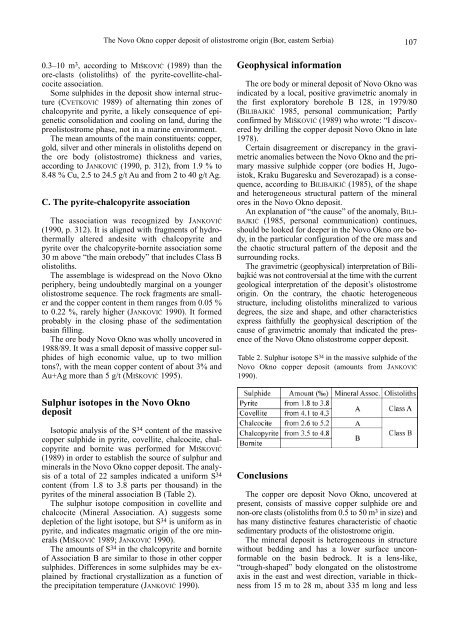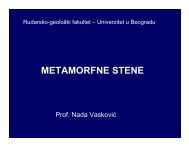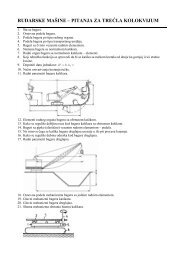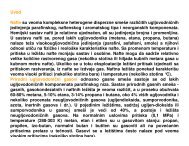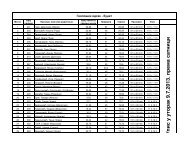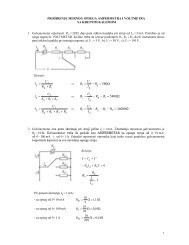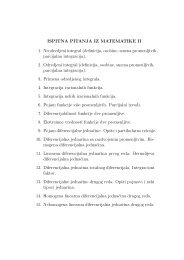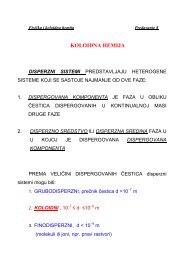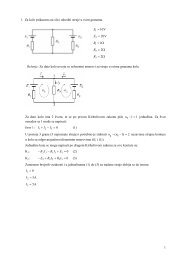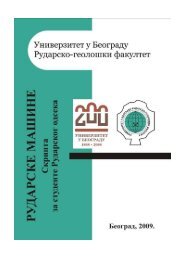KÑига LXXII
KÑига LXXII
KÑига LXXII
Create successful ePaper yourself
Turn your PDF publications into a flip-book with our unique Google optimized e-Paper software.
The Novo Okno copper deposit of olistostrome origin (Bor, eastern Serbia) 107<br />
0.3–10 m 3 , according to MIŠKOVIĆ (1989) than the<br />
ore-clasts (olistoliths) of the pyrite-covellite-chalcocite<br />
association.<br />
Some sulphides in the deposit show internal structure<br />
(CVETKOVIĆ 1989) of alternating thin zones of<br />
chalcopyrite and pyrite, a likely consequence of epigenetic<br />
consolidation and cooling on land, during the<br />
preolistostrome phase, not in a marine environment.<br />
The mean amounts of the main constituents: copper,<br />
gold, silver and other minerals in olistoliths depend on<br />
the ore body (olistostrome) thickness and varies,<br />
according to JANKOVIĆ (1990, p. 312), from 1.9 % to<br />
8.48 % Cu, 2.5 to 24.5 g/t Au and from 2 to 40 g/t Ag.<br />
C. The pyrite-chalcopyrite association<br />
The association was recognized by JANKOVIĆ<br />
(1990, p. 312). It is aligned with fragments of hydrothermally<br />
altered andesite with chalcopyrite and<br />
pyrite over the chalcopyrite-bornite association some<br />
30 m above “the main orebody” that includes Class B<br />
olistoliths.<br />
The assemblage is widespread on the Novo Okno<br />
periphery, being undoubtedly marginal on a younger<br />
olistostrome sequence. The rock fragments are smaller<br />
and the copper content in them ranges from 0.05 %<br />
to 0.22 %, rarely higher (JANKOVIĆ 1990). It formed<br />
probably in the closing phase of the sedimentation<br />
basin filling.<br />
The ore body Novo Okno was wholly uncovered in<br />
1988/89. It was a small deposit of massive copper sulphides<br />
of high economic value, up to two million<br />
tons?, with the mean copper content of about 3% and<br />
Au+Ag more than 5 g/t (MIŠKOVIĆ 1995).<br />
Geophysical information<br />
The ore body or mineral deposit of Novo Okno was<br />
indicated by a local, positive gravimetric anomaly in<br />
the first exploratory borehole B 128, in 1979/80<br />
(BILIBAJKIĆ 1985, personal communication; Partly<br />
confirmed by MIŠKOVIĆ (1989) who wrote: “I discovered<br />
by drilling the copper deposit Novo Okno in late<br />
1978).<br />
Certain disagreement or discrepancy in the gravimetric<br />
anomalies between the Novo Okno and the primary<br />
massive sulphide copper (ore bodies H, Jugoistok,<br />
Kraku Bugaresku and Severozapad) is a consequence,<br />
according to BILIBAJKIĆ (1985), of the shape<br />
and heterogeneous structural pattern of the mineral<br />
ores in the Novo Okno deposit.<br />
An explanation of “the cause” of the anomaly, BILI-<br />
BAJKIĆ (1985, personal communication) continues,<br />
should be looked for deeper in the Novo Okno ore body,<br />
in the particular configuration of the ore mass and<br />
the chaotic structural pattern of the deposit and the<br />
surrounding rocks.<br />
The gravimetric (geophysical) interpretation of Bilibajkić<br />
was not controversial at the time with the current<br />
geological interpretation of the deposit’s olistostrome<br />
origin. On the contrary, the chaotic heterogeneous<br />
structure, including olistoliths mineralized to various<br />
degrees, the size and shape, and other characteristics<br />
express faithfully the geophysical description of the<br />
cause of gravimetric anomaly that indicated the presence<br />
of the Novo Okno olistostrome copper deposit.<br />
Table 2. Sulphur isotope S 34 in the massive sulphide of the<br />
Novo Okno copper deposit (amounts from JANKOVIĆ<br />
1990).<br />
Sulphur isotopes in the Novo Okno<br />
deposit<br />
Isotopic analysis of the S 34 content of the massive<br />
copper sulphide in pyrite, covellite, chalcocite, chalcopyrite<br />
and bornite was performed for MIŠKOVIĆ<br />
(1989) in order to establish the source of sulphur and<br />
minerals in the Novo Okno copper deposit. The analysis<br />
of a total of 22 samples indicated a uniform S 34<br />
content (from 1.8 to 3.8 parts per thousand) in the<br />
pyrites of the mineral association B (Table 2).<br />
The sulphur isotope composition in covellite and<br />
chalcocite (Mineral Association. A) suggests some<br />
depletion of the light isotope, but S 34 is uniform as in<br />
pyrite, and indicates magmatic origin of the ore minerals<br />
(MIŠKOVIĆ 1989; JANKOVIĆ 1990).<br />
The amounts of S 34 in the chalcopyrite and bornite<br />
of Association B are similar to those in other copper<br />
sulphides. Differences in some sulphides may be explained<br />
by fractional crystallization as a function of<br />
the precipitation temperature (JANKOVIĆ 1990).<br />
Conclusions<br />
The copper ore deposit Novo Okno, uncovered at<br />
present, consists of massive copper sulphide ore and<br />
non-ore clasts (olistoliths from 0.5 to 50 m 3 in size) and<br />
has many distinctive features characteristic of chaotic<br />
sedimentary products of the olistostrome origin.<br />
The mineral deposit is heterogeneous in structure<br />
without bedding and has a lower surface unconformable<br />
on the basin bedrock. It is a lens-like,<br />
“trough-shaped” body elongated on the olistostrome<br />
axis in the east and west direction, variable in thickness<br />
from 15 m to 28 m, about 335 m long and less


